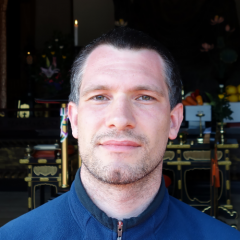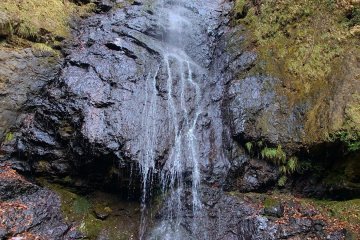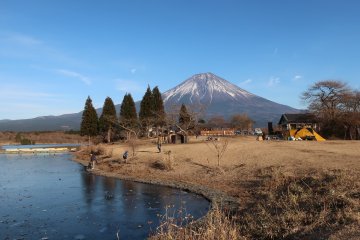Uncover authentic Japan with exciting, unique activities in English and other languages. At the 550 year old Kakurinbo shukubo (Buddhist temple lodge), on Mt. Minobu (near Mt. Fuji), you will be greeted by friendly priests and multilingual working holiday visa holders. They will introduce you to 25 authentic experiences mostly specific to Japan or even Yamanashi prefecture. Kakurinbo has received national awards for inbound travel, hospitality, and vegan food, which will assure you exceptional quality and memorable experiences. All religious faiths and genders are welcome. Conveniently, the activities are weatherproof (except cycling and helicopter tours). Plan your trip of discovery!
New — Helicopter Tours of Mt. Fuji and Mt. Minobu
From the sky at close range, behold the majestic Mt.Fuji and Mt. Minobu, one of the Three Great Buddhist Mountains of Japan (along with Mt. Koya and Mt. Hiei). Exciting and safe helicopter rides of varied durations with a licensed pilot will provide a memory of a lifetime, whether you simply admire the panorama of the Kofu Basin and Fuji Five Lakes with friends and family or experience exclusive luxury holidays for an anniversary or marriage proposal. Available all year round, even a 20-minute private helicopter ride from Mt. Minobu can become your best adventure ever!
First time: #MountFuji from a #helicopter with a Buddhist monk during a #luxury consulting/writing trip in #Minobu organised by Kakurinbo temple lodging. 120 kg per person max. Best views in January (sun + clear air + snow cap), February (peach blossoms) and autumn (leaves). #Yamanashi #JapanTravel
— Sébastien Duval (@sebastienplus.bsky.social) 20 May 2025 at 17:20
[image or embed]
Travel tips:
- Taking off from Yamanashi prefecture; mid-November to mid-January holds the best views for helicopter tours and selfies from the cockpit, thanks to minimal rainfall, low humidity (ensuring excellent visibility), and the white snowcap on Mount Fuji.
- March features fields of cherry and peach blossoms.
- Mid-October to late November features yellow, orange and red autumn leaves.
- From June to September, this area's summers are lush but prone to rain (⅔ of days) and typhoons, so other periods are advisable.
- Roundtrip helicopter rides for groups to and from the Kakurinbo vicinity start at ¥66,000 per person (approx. USD 450 or EUR 400).
- For couples, the most exciting tour is the private helicopter ride between Tokyo and Mt. Minobu. Roundtrip fare: ¥275,000 per person (approx. USD 1,900 or EUR 1,650).



Unique Regional Activities On Mt. Minobu
Best Inbound Travel at the 2024 Japan Travel Awards, Kakurinbo offers seven unique regional, enriching activities, some suitable for corporate team-building. Unlisted experiences include free demonstrations of festival performances featuring a matoi pole (signal flag from the Edo period), one-time-only performances by Yuranza artists-in-residence, prayers for eyesight healing or safe driving…
Akebono miso making: With Kakurinbo's proprietress or a local grower, cook a nutritious paste from large sweet Akebono soybeans that Japan's Ministry of Agriculture protects as unique to Minobu (Geographical Indication №119) to be fermented over months. Japan residents can bring some home, whereas international tourists can taste pre-cooked samples. Miso fermentation and Buddhism reached Japan about 1,500 years ago.

Amehata inkstone making: Inkstones are the traditional ink holders used for calligraphy, sutra copying, etc. An experienced artisan will teach you the traditional techniques of how to chisel and grind the stone to form the ink well. You will use local Amehata stone, which is hard, rough, nonabsorbent, and exquisite. On a par with top Chinese inkstones, Amehata’s continue to be used by Japan's Imperial Household Agency.

Award-winning yuba cooking: Yuba is a soybean-based, protein-rich ingredient added to Japanese and other East Asian dishes. Pick and savor the delicate, silky tofu film continuously forming when boiling soy milk. East Asians consume it fresh, fermented, or dried. In Japan, yuba (tofu skin) is a favorite; it is vegan, gluten-free, and tasty. Using locally grown Akebono soybeans, Kakurinbo won Japan's 2000 National Yuba Cooking Contest.

Buddhist/Japanese cooking class: With Kakurinbo's proprietress, cook and savor regional cuisine using local seasonal vegetables to prepare recipes suitable for vegans and vegetarians. Japan's Agency for Cultural Affairs awarded “100-Year Food” prizes for her natto (2022) and hoto udon noodles (2023).

Minobusan guided tour: Minobusan area is the birthplace of the Nichiren Buddhist tradition. Discuss with a bilingual Buddhist priest while visiting holy sites like the venerable Nichiren's tomb and Kuon-ji head temple on Mt. Minobu. Opposing earlier Buddhist teachings, Nichiren believed women could attain enlightenment. Nowadays, 800-year-old Nichiren Buddhism is internationally prominent. In spring, you can admire many weeping cherry trees.


Shodaigyo chanting: Chant with a Buddhist priest (thus walking Buddha's path together), living a core practice of Nichiren Buddhism. Inside Kakurinbo's temple hall, cleanse your mind through the rhythmic, meditative sound of Nichiren's mantra "Namu Myoho Renge Kyo" (notably translated as "Homage to the Sublime Dharma of the Lotus Sutra").

Yamanashi winery tour: Enjoy grape wine tasting at Domaine Hide winery, which grows indigenous, fruity, aromatic Muscat Bailey A. Their red grapes contain no chemical pesticides, and their wine is exported to Europe. Birthplace of Japanese winemaking (1877) and winner of international wine competitions, Yamanashi prefecture produces the most grapes (25%) and wine (30%) in Japan.

Common Japanese Activities On Mt. Minobu
Kakurinbo also offers:
-
Buddhist rosary making: Craft a rosary by selecting stones with diverse meanings/stories as prayer beads.
-
Buddhist statuette carving: With a Buddhist statue sculptor, carve a palm-sized wooden Daruma (founder of Zen Buddhism).

-
E-bike rental: Cyclists may reach the nearest of Fuji Five Lakes, Motosu.
-
Goshuin handbook making: Craft a book to collect calligraphy/stamps at Japanese temples/shrines, recording your bonds with Buddha and gods.
-
Japanese calligraphy: Write your chosen kanji on washi traditional paper using a calligraphy brush.
-
Japanese tea ceremony: Experience the minimalistic grace of this 500-year-old art, and drink matcha green tea on tatami mats.

-
Karaoke bar: Sing with the locals after dark.
-
Kintsugi: Repair broken pottery using urushi lacquer and powdered gold. Afterwards, look upon your handiwork and ponder the inevitability of change, beauty of wastelessness, value of imperfection, and attachment to gifts/heirlooms.
-
Morning yoga: Cultivate calm and energy through meditative yoga inside Kakurinbo's temple hall.

-
Onigiri & inarizushi making: Prepare rice-filled fried tofu pouches, and seaweed-wrapped rice balls containing ingredients like pickled plums.
-
Personal hanko seal making: Hand-carve your personal hanko, a seal that is used in place of a signature on documents, artworks, etc. Neighboring Rokugo town has famously produced high-quality seals for centuries.
-
Sake brewery tour: Taste rice wine, observe its making, and meet a brewer in nearby Masuho town, at the 230-year-old Shunnouten sake brewery, which uses only locally grown rice and water from the local spring. Myths suggest that Shinto gods taught sake-making to humans.
-
Sutra copying: Practice calligraphy meditation, writing Buddha's teachings on washi Japanese paper using a calligraphy brush.

-
Udon making: Knead dough made from local flour, then taste the difference with commercial noodles.

-
Washi paper making: Make traditional Japanese paper in nearby Nishijima village. Water-resistant and stretchy rather than falling apart upon repeatedly folding. Washi is favored for origami and cosplay.
-
Wedding kimono experience: Choose from 18 photoshoot-worthy dresses formerly worn by brides and from montsuki-hakama traditionally worn by grooms.
-
Wine bottle label making: Personalize a washi label with a calligraphy brush and ink for a takeaway bottle of spirits.
Exceptional & Comfortable Stay
Off-the-beaten-track, quiet Minobu is suitable for a temple stay or holiday at a private house. Taste Kakurinbo's shojin-ryori Buddhist cuisine (vegan and gluten-free dishes available)!

Warm even in winter, Kakurinbo's main building features rooms with tatami mats for solo pilgrims, tourists, couples, families, and friends. Big rooms with garden views were formerly used to host high priests or prepare memorial services. The VIP guest room feels like a shukubo as it was reserved for high priests participating in Buddhist memorial services. Some rooms have private toilets. Large baths on the ground floor are available for private use during 30-minute slots but the family guest room includes its own bathing rooms too.

Nearby among shade trees, three new chalets ("Buddha", "Dharma", "Priest") are also available with private toilets.
National cultural asset and 2022 Omotenashi (Hospitality) Selection winner, the recently-renovated 90-year-old Guest Villa Ebisuya welcomes up to six guests with Japanese-style rooms, Western-style rooms, Yamanashi artworks, a kitchen, an outdoor deck, and indoor/outdoor baths fed by Mt. Minobu's only hot spring source. Zencho (Farmer's) Café is just beside it.

Bookings & Itineraries
Check Kakurinbo's website for more details, including prices, and bookings for individual activities. To organize one-day tours in English, contact the Houdini Corporation travel agency in Yamanashi prefecture. For broader itinerary ideas and multi-day personalized trips including activities in Minobu, contact our Japan Travel travel agents in English, French, German, or Italian. You may also learn more about the region in "Whispers of Time & Wisdom in Minobu".




















